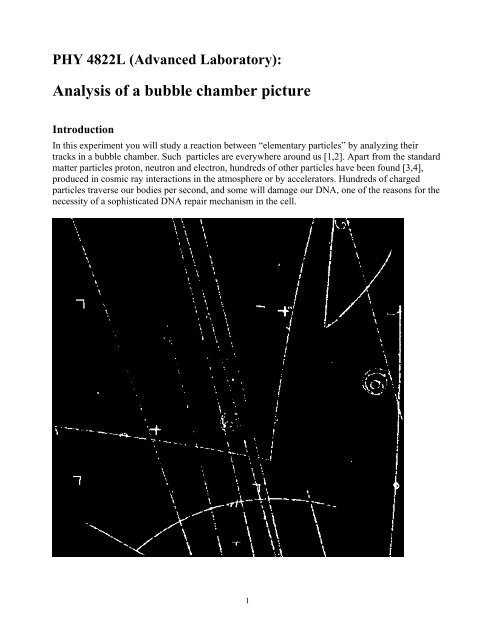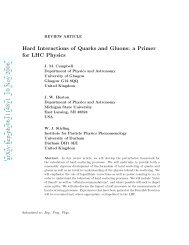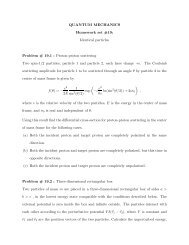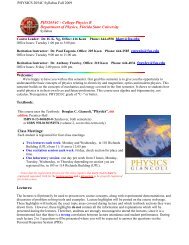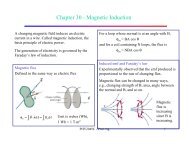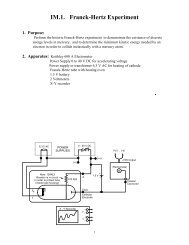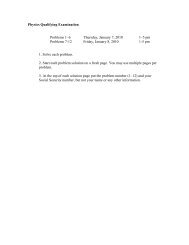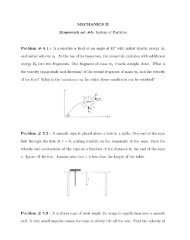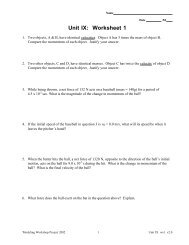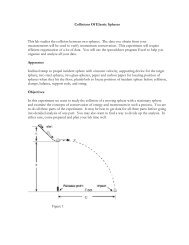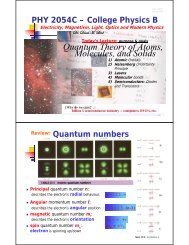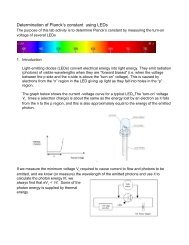You also want an ePaper? Increase the reach of your titles
YUMPU automatically turns print PDFs into web optimized ePapers that Google loves.
PHY 4822L (Advanced Laboratory):<strong>Analysis</strong> <strong>of</strong> a <strong>bubble</strong> <strong>chamber</strong> <strong>picture</strong>IntroductionIn this experiment you will study a reaction between “elementary particles” by analyzing theirtracks in a <strong>bubble</strong> <strong>chamber</strong>. Such particles are everywhere around us [1,2]. Apart from the standardmatter particles proton, neutron and electron, hundreds <strong>of</strong> other particles have been found [3,4],produced in cosmic ray interactions in the atmosphere or by accelerators. Hundreds <strong>of</strong> chargedparticles traverse our bodies per second, and some will damage our DNA, one <strong>of</strong> the reasons for thenecessity <strong>of</strong> a sophisticated DNA repair mechanism in the cell.1
where the neutral particles Λ o and K o decay as follows:Λ o → p + π - , K o → π + + π - .In this experiment, we assume the masses <strong>of</strong> the proton (m p = 938.3 MeV/c 2 ) and the pions (m π + =m π - = 139.4 MeV/c 2 ) to be known precisely, and we will determine the masses <strong>of</strong> the Λ 0 and the K 0 ,also in these mass energy units.Momentum measurementIn order to “reconstruct” the interaction completely, one uses the conservation laws <strong>of</strong> (relativistic)momentum and energy, plus the knowledge <strong>of</strong> the initial pion beam parameters (mass andmomentum). In order to measure momenta <strong>of</strong> the produced charged particles, the <strong>bubble</strong> <strong>chamber</strong> islocated inside a magnet that bends the charged particles in helical paths. The 1.5 T magnetic field isdirected up out <strong>of</strong> the photograph. The momentum p <strong>of</strong> each particle is directly proportional to theradius <strong>of</strong> curvature R, which in turn can be calculated from a measurement <strong>of</strong> the “chord length” Land sagitta s as:r = [L 2 /(8s)] + [s/2] ,Note that the above is strictly true only if all momenta are perfectly in the plane <strong>of</strong> the photograph;in actual experiments stereo photographs <strong>of</strong> the interaction are taken so that a reconstruction in allthree dimensions can be done. The interaction in this photograph was specially selected for itsplanarity.In the reproduced photograph the actual radius <strong>of</strong> curvature R <strong>of</strong> the track in the <strong>bubble</strong> <strong>chamber</strong> ismultiplied by the magnification factor g, r = gR. For the reproduction in Figure 3, g = height <strong>of</strong>photograph (in mm) divided by 173 mm.The momentum p <strong>of</strong> the particles is proportional to their radius <strong>of</strong> curvature R in the <strong>chamber</strong>. Toderive this relationship for relativistic particles we begin with Newton's law in the form:F = dp/dt = e v×B(Lorentz force).Here the momentum (p) is the relativistic momentum m v γ, where the relativistic γ-factor is definedin the usual wayγ = [√(1- v 2 /c 2 )] -1 .Thus, because the speed v is constant:F = dp/dt = d(mvγ)/dt = mγ dv/dt = mγ (v 2 /R)(-r) = e v B (-r) ,where r is the unit vector in the radial direction. Division by v on both sides <strong>of</strong> the last equalityfinally yields:mγv /R = p /R = e B ,identical to the non-relativistic result! In “particle physics units” we find:p c (in eV) = c R B , (1)3
thus p (in MeV/c) = 2.998•10 8 R B •10 -6 = 300 R (in m) B (in T)Measurement <strong>of</strong> anglesDraw straight lines from the point <strong>of</strong> primary interaction to the points where the Λ 0 and the K 0decay. Extend the lines beyond the decay vertices. Draw tangents to the four decay product tracks atthe two vertices. (Take care drawing these tangents, as doing it carelessly is a source <strong>of</strong> largeerrors.) Use a protractor to measure the angles <strong>of</strong> the decay product tracks relative to the parentdirections (use Fig. 3 or 4 for measurements and Fig. 2 for definitions).Note: You can achieve much better precision if you use graphics s<strong>of</strong>tware to make themeasurements, rather than ruler and protractor on paper. Examples <strong>of</strong> suitable programs areGIMP or GoogleSketchUp, both <strong>of</strong> which can be obtained for free.<strong>Analysis</strong>The laws <strong>of</strong> relativistic kinematics relevant to this calculation are written below. We use thesubscripts zero, plus, and minus to refer to the charges <strong>of</strong> the decaying particles and the decayproducts.p + sinθ + = p - sinθ - (2)p 0 = p + cosθ + + p - cosθ - (3)E 0 = E + + E - ,where E + = √(p + 2 c 2 + m + 2 c 4 ) , and E - = √(p - 2 c 2 + m - 2 c 4 )m 0 c 2 = √(E 0 2 - p 0 2 c 2 )Note that there is a redundancy here. That is, if p + , p - , θ + , and θ - are all known, equation (2) is notneeded to find m 0 . In our two-dimensional case we have two equations (2 and 3), and only oneunknown quantity m 0 , and the system is over-determined. This is fortunate, because sometimes (ashere) one <strong>of</strong> the four measured quantities will have a large experimental error. When this is the case,it is usually advantageous to use only three <strong>of</strong> the variables and to use equation (2) to calculate thefourth. Alternatively, one may use the over-determination to "fit'' m 0 , which allows to determine itmore precisely.A. K 0 decay1. Measure three <strong>of</strong> the quantities r + , r - , θ + , and θ - . Omit the one which you believe wouldintroduce the largest experimental error if used to determine m K . Estimate the uncertainty <strong>of</strong>your measurements.2. Use the magnification factor g to calculate the actual radii R and equation (1) to calculate themomenta (in MeV/c) <strong>of</strong> one or both pions.3. Use the equations above to determine the rest mass (in MeV/c 2 ) <strong>of</strong> the K o .4. Estimate the error in your result from the errors in the measured quantities.5.4
Β. Λ o decay:1. The proton track is too straight to be well measured in curvature. Note that θ + is small anddifficult to measure, and the value <strong>of</strong> m Λ is quite sensitive to this measurement. Measure θ + , r -and θ - . Estimate the uncertainty on your measurements.2. Calculate m Λ and its error the same way as for the K o .3. Estimate the error in your result from the errors in the measured quantities.4. Finally, compare your values with the accepted mass values (the world average) [3], anddiscuss.C. Lifetimes:Measure the distance traveled by both neutral particles and calculate their speed from theirmomenta, and hence determine the lifetimes, both in the laboratory, and in their own rest-frames.Compare the latter with the accepted values [3]. Estimate the probability <strong>of</strong> finding a lifetime valueequal or larger than the one you found.References:[1] G.D. Coughlan and J.E. Dodd: “The ideas <strong>of</strong> particle physics”, Cambridge Univ. Press,Cambridge 1991[2] “The Particle Adventure”, http://particleadventure.org/[3] Review <strong>of</strong> Particle Physics, by the Particle Data Group, Physics Letters B 592, 1-1109(2004) (latest edition available on WWW: http://pdg.lbl.gov )[4] Kenneth Krane: Modern Physics, 2nd ed.; John Wiley & Sons, New York 1996[5] see, e.g. K. Kleinknecht: “Detectors for Particle Radiation”, Cambridge University Press,Cambridge 1986;R. Fernow: “Introduction to Experimental Particle Physics”, Cambridge University Press,Cambridge 1986;W. Leo: Techniques for Nuclear and Particle Physics Experiments :A How-To Approach; Springer Verlag, New York 1994 (2 nd ed.)Note: Experiment adapted from PHY 251 lab at SUNY at Stony Brook (Michael Rijssenbeek)5
Figure 3 : Photograph <strong>of</strong> the interaction between a high-energy π - -meson from the BerkeleyBevatron accelerator and a proton in a liquid hydrogen <strong>bubble</strong> <strong>chamber</strong>. The interaction producestwo neutral particles Λ 0 and K 0 , which are short-lived and decay into charged particles a bit further.The photo covers an area (H•W) <strong>of</strong> 173 mm • 138 mm <strong>of</strong> the <strong>bubble</strong> <strong>chamber</strong>. In this enlargement,the magnification factor g = (height (in mm) <strong>of</strong> the photograph )/173 mm.6
Fig. 4: Negative <strong>of</strong> <strong>picture</strong> shown in Fig. 37


